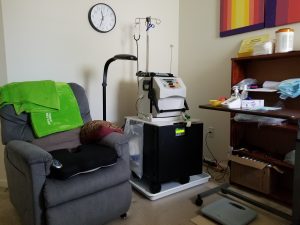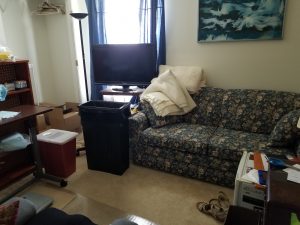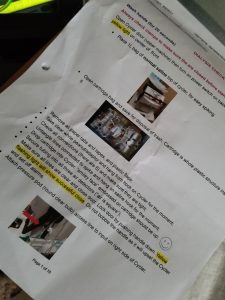It once seemed inconceivable that we—or anyone–would operate a dialysis center in a spare bedroom. If a medical treatment must consume most of your attention and half your week, then bringing it home makes a certain amount of sense.
When the Kidneys Give Out
For four or five years, we knew that dialysis was likely inevitable, given the declining health of my Dear One’s kidneys. Three years ago, a vascular surgeon created a fistula in his left arm. Despite the resulting numbness and chill resulting from the reduced blood flow to his fingers, we forged ahead. We struggled with the kidney diet but still his numbers trended in the wrong direction. Weight fell from his already thin body.
Finally we looked at our nephrologist, Dr P, and agreed, “it’s time.”
Taking Dialysis Home
In a flash, or so it seemed, we had an appointment at the Fresenius Kidney Care Center in Baltimore and were introduced to Arlene, the RN heading up our care team. She is a remarkable educator and human being. Dialysis training was scheduled to last—formally—about six weeks, Monday, Tuesday, Thursday and Friday, for about four hours each day. Training meant that my Dear One was dialyzed for about two hours and I was taught how to manage the machinery. And cannulating skills. Cannulating is the matter of sticking the patient with a set of needles, one to take arterial blood to the dialyzer and the other to return the cleaned blood to the venous system.
Arterial lines are always marked by red, venous by blue. Saline lines are white, dialysis lines are green and waste lines–the euphemism for the lines that drain what would be pee if it came out the traditional way–are yellow.
I am reassured by color-coding.
Our Private Unit
Once we selected a space for Our Private Unit (OPU), it was assessed for functionality and access to plumbing. No problem there. The equipment—a Purflow machine that makes the dialysate and a Cycler through which the dialysis lines run—take up a lot of space. A grandson and his parents came down to help us with the heavy lifting. We also removed all the doors, privacy not being a huge issue and storage for supplies being an immense issue. My Tattooed Boy later helped me move a chest of drawers and bring his college-era refrigerator upstairs. And an unused bookshelf as well. I did visit Amazon for a hospital table and a rolling stool. And a wall clock. One always needs a wall clock.
Keeping Things Under Control
At home, the schedule is Monday, Tuesday, Thursday and Saturday. Wednesday and Fridays are reserved for medical appointments, especially those of the lengthier kinds. Sunday, the day family events are most likely to take place, is similarly open. While my Dear One prefers treatments in the early afternoon, we aren’t tied to a rigid schedule.
When all goes smoothly, as it did today, I lounge on the couch, recording my Dear One’s blood pressure every thirty minutes, and catching up on my reading. Yes, the unexpected benefit of dialysis: reading time for me.
Occasionally there are alarms and other events. Got a “39” this past Saturday. Turns out that we simply ran out of time on the dialysate batch, as it was prepared the previous Tuesday afternoon and it has a sell-by date of seventy-nine hours. When the time is up, it is up. Fortunately Arlene was available to help and confirmed that the only thing to do was cut the session short, rinseback and finish up. We didn’t lose a lot of treatment time—and now I know that preparing a batch for Thursday and Saturday needs to be done Wednesday evening.
On Our Own
It’s still a little unnerving to be on our own. When I am wakeful at night I obsess about all the things that could go wrong, about bad cannula sticks and infiltrating or piercing the wall of the fistula. Yes. Ick.
I am compulsive about what Arlene calls “clampy-clampy” or being sure the clamps on various tubes are either open or closed as need be. The official checklist that must be done before treatment is initiated by pressing the green kidney-shaped start button is invaluable. Then there is my own checklist, Arlene’s brief four-page outline elaborated to fill nine pages. Lots of color-coding, too.
So far, so good. And so far, every issue has been a learning opportunity. There is still a lot to learn.



